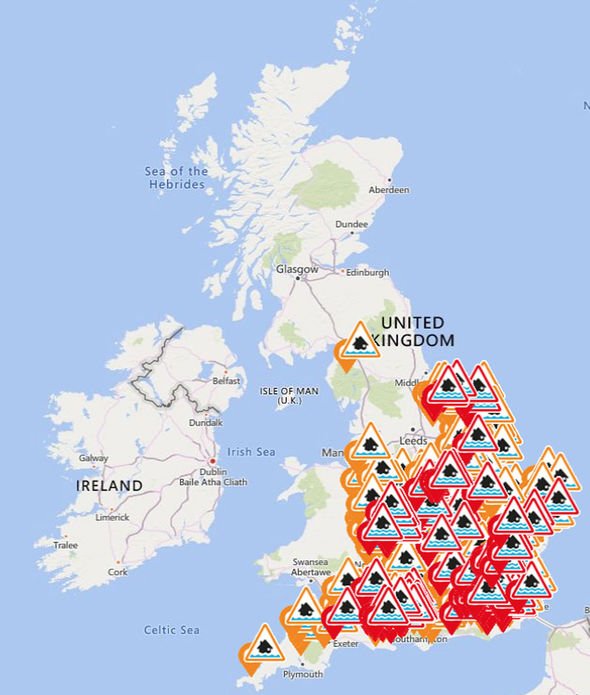Flood Alerts: Knowing The Signs And Taking Action

Table of Contents
Recognizing the Signs of an Impending Flood
Early detection is key to flood safety. Being aware of potential flood indicators can give you precious time to prepare and protect yourself and your family. Several signs might indicate an impending flood, and it's crucial to be vigilant and observant. Key indicators include:
- Rapidly rising water levels in rivers, streams, or creeks: Observe changes in local water bodies. A sudden and significant increase in water levels is a major warning sign.
- Heavy and persistent rainfall over a short period: Intense rainfall, especially over saturated ground, significantly increases the risk of flash floods and river flooding. Monitor weather forecasts closely.
- Official flood warnings or watches issued by local authorities or meteorological services: Pay close attention to official warnings and alerts issued through weather apps, news broadcasts, and local emergency services. These alerts are designed to inform the public of potential flood risks.
- Swollen rivers exceeding their banks: If you see rivers overflowing their banks, it's a clear indication that flooding is imminent or already occurring.
- Unusual sounds like rushing water or debris: Listen for unusual sounds, which can indicate rapidly moving water and potential danger.
- Changes in animal behavior, such as animals leaving low-lying areas: Animals often exhibit early warning signs of impending danger, such as moving to higher ground.
Stay informed about weather forecasts and official flood alerts. Observe changes in your local environment and be aware of subtle indicators of rising water levels. Remember that even small changes can be significant early warning signs.
Understanding Different Types of Flood Alerts
Understanding the terminology used in flood alerts is critical for effective response. Different alerts indicate varying levels of risk and require different actions. Familiarize yourself with the following types of flood alerts:
- Flood Watch: A flood watch means conditions are favorable for flooding. This is not an immediate threat, but it's a call to action to prepare. Monitor conditions closely and be ready to act if a warning is issued.
- Flood Warning: A flood warning indicates that flooding is occurring or is imminent. This is a serious alert requiring immediate action. Follow your emergency plan and prepare for potential evacuation.
- Flash Flood Warning: A flash flood warning signifies a sudden and rapid flood is happening. This is an extremely dangerous situation demanding immediate action. Seek higher ground immediately and evacuate if necessary. Flash floods can develop within minutes and can be incredibly destructive.
Familiarize yourself with your local emergency alert systems, including how they will notify you of watches and warnings. Register for emergency alerts through your local authorities and mobile device settings.
Creating a Flood Preparedness Plan
Proactive preparation is essential for minimizing the impact of a flood. A well-defined plan will reduce stress and increase your ability to respond effectively during a flood event. Your plan should include:
- Develop an evacuation plan and identify safe routes and meeting points: Plan multiple escape routes from your home and designate a safe meeting point for your family. Practice your evacuation plan regularly, particularly with children.
- Create a flood emergency kit including essential supplies (water, food, first-aid, medications): Prepare a kit containing essential supplies for at least 72 hours, including water, non-perishable food, first-aid supplies, medications, flashlights, batteries, and important documents.
- Elevate valuable items and important documents: Move valuable possessions and important documents to higher floors or safer locations.
- Secure your property by moving outdoor furniture and securing loose objects: Secure or move any outdoor items that could be carried away by floodwaters. This will prevent damage to your property and prevent debris from becoming dangerous projectiles.
- Consider flood insurance to protect your financial assets: Flood insurance is crucial in mitigating financial losses in the event of a flood. Check with your insurance provider to determine your coverage options.
Taking Action During a Flood
Your safety is the top priority during a flood. Immediate and decisive action can save lives. Remember to:
- Evacuate immediately if instructed by authorities: Obey all instructions from emergency services and local authorities. Evacuation orders are for your safety.
- Never drive through flooded areas; even shallow water can be dangerous: Floodwaters can be deceptively deep and fast-moving, potentially sweeping vehicles away. Never attempt to drive through standing water.
- Seek higher ground or go to a designated evacuation shelter: If evacuation is necessary, seek higher ground or go to a designated evacuation shelter. Stay informed about shelter locations in your area.
- Turn off utilities (gas, electricity) if safe to do so: If it's safe to do so, turn off gas and electricity to prevent electrical hazards and potential gas leaks.
- Contact emergency services if you need help: If you require assistance, contact your local emergency services immediately.
Conclusion
Being prepared for floods is crucial in protecting your life, your family, and your property. By understanding flood alerts, recognizing warning signs, and developing a comprehensive preparedness plan, you can significantly reduce your risk. Remember to stay informed about weather conditions and official alerts issued by your local authorities and meteorological services.
Call to Action: Stay informed and prepared. Learn more about flood alerts in your area and develop your own flood preparedness plan today! Don't wait for a flood warning – take action to protect yourself and your loved ones. Prioritize flood safety and be ready for any severe weather event.

Featured Posts
-
 Link Live Streaming Moto Gp Inggris 2025 Saksikan Sprint Race Pukul 20 00 Wib
May 26, 2025
Link Live Streaming Moto Gp Inggris 2025 Saksikan Sprint Race Pukul 20 00 Wib
May 26, 2025 -
 L Animateur Ardisson Se Defend Contre Les Accusations De Baffie
May 26, 2025
L Animateur Ardisson Se Defend Contre Les Accusations De Baffie
May 26, 2025 -
 Mzahrat Mtwaslt Btl Abyb Mtalb Bitlaq Srah Alasra
May 26, 2025
Mzahrat Mtwaslt Btl Abyb Mtalb Bitlaq Srah Alasra
May 26, 2025 -
 The Hells Angels An Examination Of A Notorious Motorcycle Gang
May 26, 2025
The Hells Angels An Examination Of A Notorious Motorcycle Gang
May 26, 2025 -
 Moto Gp Inggris 2025 Jadwal Lengkap Siaran Langsung Trans7 And Spotv Dan Klasemen
May 26, 2025
Moto Gp Inggris 2025 Jadwal Lengkap Siaran Langsung Trans7 And Spotv Dan Klasemen
May 26, 2025
Latest Posts
-
 Test Du Samsung Galaxy S25 256 Go Top Produit Ou Non
May 28, 2025
Test Du Samsung Galaxy S25 256 Go Top Produit Ou Non
May 28, 2025 -
 18000
May 28, 2025
18000
May 28, 2025 -
 Galaxy S25 512 Go Un Bon Plan A Saisir A 985 56 E
May 28, 2025
Galaxy S25 512 Go Un Bon Plan A Saisir A 985 56 E
May 28, 2025 -
 Samsung Galaxy S25 256 Go Le Top Produit A 775 E
May 28, 2025
Samsung Galaxy S25 256 Go Le Top Produit A 775 E
May 28, 2025 -
 6000
May 28, 2025
6000
May 28, 2025
